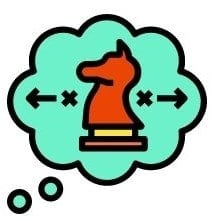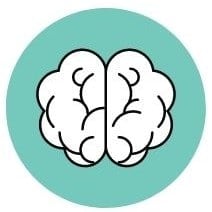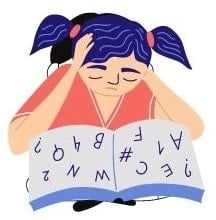
Reading skills are mental skills that allow a person to decode, read, comprehend, and interpret the written word.
Reading is a fundamental but complex skill that children must acquire because they must learn to read before they can read to learn. Some say reading is more than a skill; it is an art in its own right. Unfortunately, many children never completely master this essential skill or art form.
Before building a house, one needs to lay a foundation. In the same way, there are preparatory and supportive skills that children must acquire before it becomes possible for them to master the art of reading. We discuss the various types of preparatory and supportive reading skills, the four stages of reading skills development, four types of reading difficulties, and how to develop reading skills.
Table of contents:
- 8 Types of reading skills
- 4 Stages of reading skills development
- 4 Types of reading difficulties
- Developing reading skills
- Key takeaways
8 Types of reading skills
There are a variety of preparatory and supportive reading skills:

(1.) Decoding
To be a good reader, you have to be able to decode words. Decoding is the ability to apply your knowledge of letter-sound relationships and letter patterns and correctly pronounce written words.
To decode a word,
(a.) you need to know which sound or sounds each letter makes, like how a g sounds in game and how it sounds in gym;
(b.) how to take apart the individual sounds in a word and blend them, e.g., with man the first sound is /m/, the next sound is /ă/, and the last sound is /n/; and
(c.) how groups of letters can work together to make a single sound, like sh in ship.
Understanding letter-sound relationships allow children to recognize familiar words quickly and figure out unfamiliar words.
If attention is drained by decoding words, little or no capacity is available for the attention-demanding process of reading comprehension. Therefore, the automaticity of decoding is essential.
Although children may sometimes figure out some letter-sound relationships by themselves, most children benefit from explicit instruction. Phonics is one approach to reading instruction that teaches students the principles of letter-sound relationships, how to sound out words, and the exceptions to these principles.

(2.) Phonological and phonemic awareness
Decoding relies heavily on phonological awareness, which refers to an individual’s awareness of the sound structure of language. A listening skill, phonological awareness is the ability to distinguish between speech units such as rhymes, syllables in words, and individual phonemes in syllables.
Phonological awareness is often confused with phonics. The latter requires students to know and match letters or letter patterns with sounds, learn spelling rules, and use this information to decode (read) and encode (write) words. Phonological awareness relates only to speech sounds, not alphabet letters or sound-spellings.
Phonemic awareness is a subset of phonological awareness that focuses on recognizing and manipulating phonemes, the smallest sound units. Two crucial phonemic awareness skills are segmenting and blending.

(3.) Reading fluency
Sounding out or decoding every word can take much effort. Fluency, defined as “speed, accuracy, and proper expression,” gained prominence when it was included as one of five essential reading skills in a national-level research synthesis on reading instruction.
To read fluently, readers need effective word recognition skills. Word recognition is the ability to recognize whole words instantly by sight without sounding them out.
Reading fluency speeds up the rate at which they can read and understand text. Reading fluency is also important when kids encounter irregular words, like one and the, which cannot be sounded out.
When kids can read smoothly without making too many errors, they are “fluent readers.”

(4.) Reading comprehension
Reading fluency is seen as the ‘bridge’ between decoding and comprehension. A person reading unevenly and slowly will have problems with comprehension.
Reading comprehension refers to a reader’s ability to successfully interpret a text and connect the ideas in the text to their background knowledge. Since the purpose of all reading is to gather meaning from the printed page, reading comprehension is the heart and goal of reading. According to Duffy, if we do not understand the message, we are not reading.
Readers with good reading comprehension can draw conclusions about what they read – what is the main message, what is a fact, what caused an event to happen, and which characters are funny. Thus comprehension involves combining reading with thinking and reasoning.

(5.) Vocabulary
One big part of comprehension is vocabulary knowledge, i.e., knowing the meanings of enough words.
Being able to pronounce a word correctly does not guarantee that one understands its meaning. For example, pronouncing the word archipelago correctly will not be very helpful when reading a passage about Lofoten, an archipelago in the county of Norland, Norway; it is vital that one also understands the word’s meaning, i.e., an island group.
Decades of research have confirmed the importance of vocabulary skills in reading comprehension and students’ overall academic success.

(6.) Memory
Short-term memory is the capacity for holding, but not manipulating, a small amount of information in one’s mind in an active, readily available state for a short period. Working memory is like a temporary sticky note in the brain. It holds new information so the brain can manipulate it or connect it to other data or prior knowledge. It is an essential memory system and one that most of us use daily.
Sentence comprehension depends heavily upon adequate working memory. Each sentence is read, understood, associated, and integrated with the previous one, and so forth. Eventually, after reading the entire paragraph, the reader continues to the next one. By the end of the chapter, the reader needs to retain both the details and the main idea, otherwise may recall isolated facts but may not know the sequence of events nor understand the main idea.
Auditory, visual, and visual sequential memory, and visual long-term memory, especially for details, have also been linked to reading.

(7.) Logical thinking
Logical thinking is the process in which one uses reasoning consistently to reach a conclusion. Problems or situations that involve logical thinking call for structure, relationships between facts, and chains of reasoning that “make sense.”
The relationship between logical thinking and reading is well established. It has been said that “there is no reading without reasoning,” and even that reading is reasoning.
This reading skill helps the child tie their background knowledge to new knowledge, make inferences, draw conclusions, and read between the lines.

(8.) Rapid naming
Rapid naming happens when you recognize something instantly and effortlessly and say what it is. It can be anything. It can be objects, symbols, and colors at the most basic level. At a higher level, this can include words and phrases.
Dyslexic readers frequently show weaknesses on tests of rapid naming ability. There is an ongoing debate about whether the underlying deficit is visual or phonological. However, the strong correlation between dyslexia and difficulties with rapid naming justifies its inclusion in our list of reading skills.

Other reading skills
In addition to phonological and phonemic awareness, rapid naming, and working memory, cognitive psychology has now linked several brain-based skills to reading deficits like dyslexia:
- Executive function refers to a set of skills. These skills underlie the capacity to plan ahead and meet goals, display self-control, follow multiple-step directions even when interrupted, and stay focused despite distractions.
- Visuospatial processing refers to the ability to perceive, analyze, synthesize, manipulate and transform visual patterns and images.
- Processing speed involves one or more of the following functions: the length of time it takes to perceive and process information and formulate or enact a response.
4 Stages of reading skills development

Pre-alphabetic stage
Readers at the pre-alphabetic stage have no appreciation of the alphabetic principle. Children attempt to translate the unfamiliar visual forms of print into familiar oral language through visual clues. They might remember the word monkey by associating the descending shape of the last letter with a monkey’s tail.

Partial alphabetic stage
Readers have now learned that letters and sounds are related, and they begin to use that insight. However, they are still unable to deal with the full complexity of the sounds in words, so they cannot make complete use of letter-sound relationships.
If readers at this stage learn that the letter sequence g-e-t is get, they may focus just on the g and the sound it represents to identify the word. However, using this strategy of focusing on the first letter, they may also read the letter sequences give, go, and gorilla as get.

Fully alphabetic stage
At this stage, even though they may never have seen it in print before, if they know the sounds commonly associated with the letters b-u-g, they can think about the sounds for each of the letters and blend them to arrive at the pronunciation of the word.
As a result of encountering the printed word bug several times, children can eventually accurately and instantly identify the word bug without attending to the individual letters, sounds, or letter-sound associations.

Consolidated alphabetic stage
Readers who recognize whole words instantly have reached the fourth stage. They also develop another valuable, attention-saving decoding skill. Not only do readers at this stage store words as units, but also repeated encounters with words allow them to store letter patterns across different words.
A multi-letter unit like –ent will be stored as a unit as a result of reading the words went, sent, and bent. Upon encountering the word dent for the first time, a consolidated alphabetic reader would need to connect only two units: d and –ent, rather than the four units that the fully alphabetic reader would need to combine.
4 Types of reading difficulties
While becoming a fluent reader is essential, many children never acquire this skill.
According to Dr. Reid Lyon, approximately 20 to 30 percent of school-age children have difficulties learning to read. About 15 million youngsters in the US do not have access to the wonders of books and other kinds of texts for learning and enjoyment. While these estimates are alarming, they are on the conservative side.

Poor decoding
Beginner readers may struggle when they meet new or unfamiliar terms, but typically, decoding becomes easier with repeated practice of reading the text out loud. If a child continues to struggle, there may be an underlying difficulty or a physical impairment that does not allow them to hear the sounds or see the letters.

Poor fluency
To read fluently, readers need effective word recognition skills. Word recognition can be a considerable obstacle for struggling readers. Average readers need to see a word four to 14 times before it becomes a “sight word” they automatically recognize. Children with dyslexia may need to see it up to 40+ times.

Poor comprehension
Someone can read fluently and still have poor comprehension, which has a clinical term: Specific Reading Comprehension Deficit (SRCD). SRCD happens when a child’s decoding skills are more developed than their ability to understand a text.

Mixed reading difficulties
Mixed reading difficulties include poor decoding, fluency, and difficulty with reading comprehension. They have challenges when it comes to reading words, retaining information, and understanding the text. These problems could be due to a reading disorder like dyslexia.
Developing reading skills
Effective reading instruction teaches reading on three levels:
(1.) preparatory reading skills (e.g., phonological and phonemic awareness, rapid naming, processing speed)
(2.) supportive reading skills (e.g., decoding, expanding, and learning new vocabulary)
(3.) reading strategies
Effective reading instruction is explicit and systematic.
Explicit teaching practices involve showing students what to do and how to do it. Strategies emphasizing silent, independent reading have not been proven to improve reading achievement.
Systematic teaching means skills and concepts are taught in a planned, logically progressive sequence. For example, certain sounds — those that are easier to learn or used more often — are taught before other sounds.
Are poor reading skills holding your child back?
Edublox Online Tutor is an online platform that houses a range of products and services to improve various literacy skills. Our programs include Development Tutor, Reading Tutor, and Live Tutor. Live Tutor works in conjunction with Development Tutor and is recommended for students with mild to severe reading difficulties, including dyslexia. Edublox aims to develop preparatory reading, essential reading, and comprehension skills required in the reading process.
Watch our playlist of customer reviews and book a free consultation to discuss your child’s reading needs.
Key takeaways

Authored by Sue du Plessis (B.A. Hons Psychology; B.D.), an educational specialist with 30+ years of experience in learning disabilities.
